FACE-OFF: HOUNDS BATTLE IN TOURNEY TO BE TOP DOG!
If there’s a movie that’s been made more times than THE HOUND OF THE BASKERVILLES, I don’t know what it is. IMDB lists twenty versions made between 1914 and 2002 (Sounds as if another should be due any moment.). This dog-fight will determine the best of them all, though I have to make a few cuts to trim it down to a manageable number of entrants. First, the silents go. Not fair to compare them to those new-fangled talkies. Next, the foreign (I’m not counting the UK and Canuskistan entries as foreign, since we were once one big happy family.). Although — I may try to include the Russian tv version (1981) since there appears to be copies available on Amazon and it gets really high IMBD ratings. Besides, wouldn’t you really like to see Vasili Livanov’s take on Sherlock Holmes? Next, the hopelessly obscure are dumped (eg, the 1932 UK version which hasn’t achieved a commercial DVD release). Finally, due to bracket constraints we need to narrow it down to eight contestants, so there goes the Peter Cook/Dudley Moore version. This leaves us with a field of eight films (I’m listing them by the actor who played Holmes, somewhat disguised, to help ramp up the suspense and hype):
Round One: Sir Guy of Gisbourne vs. Second BBC Dude
Round Two: Grand Moff Tarkin vs. First BBC Dude
Round Three: Max Headroom vs. Dr. Who
Round Four: Allan Quatermain (with help from SHATNER!) vs. Mr. Book (All right, that one is a little obscure; I’ll award a pat on the back to the first commentator who recognizes the reference.)
I hope that’s how this will shake out, but since I don’t have all these films in my possession, I reserve the right to substitute Russian or perhaps British comedy duo versions if those prove more accessible (ie, cheap on eBay). But let’s open the first round, with:
Basil (Sir Guy of Gisbourne) Rathbone (the first US contender; 1939) vs. Richard (Second BBC Dude, one of five UK contenders; 2002) Roxburgh. A few preliminary comments before we break down the rounds. These two films present quite contrasting versions of the HOUND. The first (1939) is an American theatrical release, black and white, shot on sound stages with a simpler, somewhat sanitized story-line. The second (2002) is a made for TV British production, color, shot at least partially on location, with a more complex, more gritty storyline. But which is the best film? And by “best film” I mean one that gives me the most viewing enjoyment.) Let us see.
Round One: Holmes’s: Rathbone played Holmes more frequently (when considering theatrically releases) than anyone (14 movies) and many consider his version of Holmes the definitive one. For Richard Roxburgh, his appearance in HOUND is a one time deal as Holmes (though he’s still working so who knows?). No doubt, Rathbone’s Holmes is the kinder, gentler version. Often laughing, always at ease, he’s not above poking a little fun at Watson. Roxburgh is much darker. He’s egotistic, supercilious, and, conceited. Though, surprisingly, both are depicted as drug users, Rathbone’s is much more discrete (the last line in the movie is, “Quick Watson, the needle!”) while Roxburgh shoots up twice during the case (which the literary Holmes never did; he used drugs — injected cocaine, I believe — to relieve ennui between cases) once showing an ugly set of track marks going up his arm. Roxburgh does more actual investigation than Rathbone, who does a lot of standing around and quipping. But much of this is a screenplay problem. (Rathbone 7; Roxburgh 3)
Round Two: Watsons: Mexican (by birth) Nigel Bruce played the bumbling Englishman frequently during his career and was the Watson to Rathbone’s Holmes throughout their long-running series. He’s a fine (if limited) actor for the type: chubby, avuncular, good-natured, and something of a dim bulb. Which is fine, but that’s not really what Watson was. His portrayal of Watson (but of course he was acting the scenes he was given) is perhaps the greatest weakness (along with, I’m assuming, a dwindling budget and increasingly simple screenplays) of the Rathbone Holmes films. His best asset is his general likeability and willingness to act as Holmes’ second fiddle. Roxburgh’s foil was Ian Hart. He makes a fine Watson. He’s more athletic, smarter, and generally more useful, though he and Holmes spend a lot of time shouting at each other (more below). (Roxburgh 6; Rathbone 4)
Round Three: Holmes and Watson together: A great deal of the appeal of all Holmes films is the relationship between Holmes and Watson. Like much of the rest of the movie, the Rathbone/ Bruce relationship is cheery, possibly excessively so, while Roxburgh and Hart go through the movie snarling at each other or arguing like an old married couple. They have no chemistry whatsoever, and simple and cheery in this case is better than none. (Rathbone version 8; Roxburgh version 2)
Round Four: Supporting Cast: The Rathbone version is filled with great character actors. Richard Greene (later Robin Hood) as the young Sir Henry; the excellent Lionel Atwill as Dr. Mortimer; Wendy Barrie (doxy of the notorious Bugsy Siegel) as Meryl Stapleton; the great John Carradine as the butler; and Morton Lowry (a weak point as John Stapleton) who is more smarmy than sinister. Granted, I am less familiar with the British cast of the Roxburgh version, but no one really stood out. (Rathbone version 6, Roxburgh 4)
Round 5: Setting: The Rathbone version was filmed on a sound stage. The sets were pretty good, but they were sound stage sets. Though we heard a lot about the awful sucking pits of the Great Grimpen Mire, we never saw them in action. While a lot of the Roxburgh version was filmed on location, oddly enough they didn’t film in the Devonshire moors as described in the book, but in Cumbria (among other places) up near the Lake District. Still, the landscapes were beautiful and sinister in turns and the interiors (whether sets or actual stately homes; I suspect mostly the later) were wonderful. The Rathbone interiors while good-looking, were clearly sets, and sanitized ones as well: much too clean, brightly lit, and non-cluttery (as opposed to actual Victorian domiciles). (Roxburgh 6, Rathbone 4)
Round 6: Screenplay: Here we come to the heart of the matter. Both obviously derive from the Doyle novel. Quite a few scenes are identical, or nearly so, though there are plenty of differences. Despite being a television production, the Roxburgh version is much more violent, gritty, and complicated. It opens with a shot of the corpse of the deceased Sir Baskerville, split through the chest with an autopsy scar. As mentioned, you get to see Sherlock shoot up a couple of times, as well as a lingering view of the tracks up his arm. Several people get sucked down one of the pits in the Great Grimpen Mire, lingeringly, including almost Sherlock Holmes in a climactic scene which shows Holmes being something of an idiot (which is a near-fatal flaw). Roxburgh’s Stapleton is a vicious, wife-beating killer and not only a murderer via the Hound, but he actually strings up his wife (who is posing as his sister) when she refuses to seduce the young Baskerville. This killing is a really unnecessary plot twist that I believe is original to this version. In contrast, the Rathbone version is so sanitized that Stapleton’s supposed sister is his STEP-sister. There is no chemistry between Holmes and Watson in the Roxburgh version. There is no chemistry between the young Baskerville and Stapleton’s step-sister in the Rathbone version. Probably the best scene in the Roxburgh version occurs when the Hound suddenly appears at the window during the seance scene; the seance scene in the Rathbone version is pointless. Speaking of pointless, the Roxburgh version adds a Christmas party (something I’ve never seen in a HOUND movie before, nor remember from the book), At the climax of the Rathbone version, Holmes simply lets Stapleton run out the door and says, well, I’ve got constables stationed on the road. Very undramatic, very unfulfilling, and almost a fatal flaw. So, both of these screenplays have problems. The Roxburgh version offers a few more thrills, but most of those (like the autopsy and the hanging scenes) are rather gratuitous. The Rathbone version does offer more engaging characters. So close I’ll split it Rathbone 5 ½, Roxburgh 4 ½..
Round 7: The Hound: Can’t have a HOUND OF THE BASKERVILLES without a Hound. In the Rathbone version that’s just what you get. A dog. He’s a big dog with lots of teeth, but he’s just a dog. Dogs have never scared me. The Roxburgh Hound is apparently a computer generated Hound. Kind of scary, kind of weird. Again, a close call, but slight edge to Roxburgh
(5 ½ to 4 ½.)
It basically comes down to the character issue. The Roxburgh version had more thrills (though some manufactured), was better looking, and had a more complicated story. The Rathbone version had more engaging characters even if the story was watered down a bit and the look of the movie was more artificial.
Round One winner is the U.S. 1939 theatrical release HOUND OF THE BASKERVILLE’S over the U. K. BBC television 2002 version, 39 to 31. Take that, Brits. Stay tuned for more rounds in this dog-take-all tournament over the next few weeks.
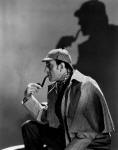

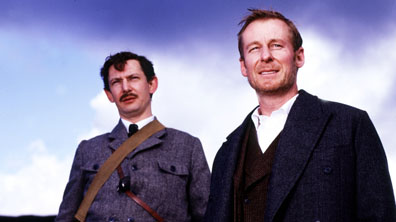
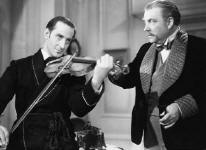
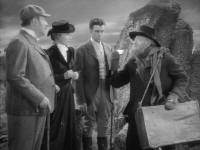
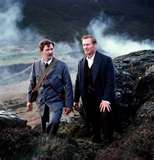
There are no comments